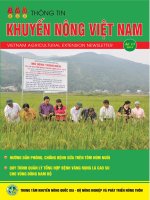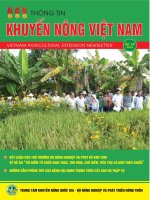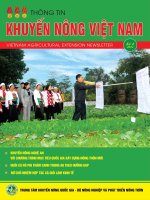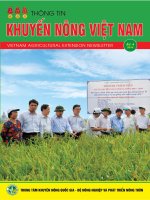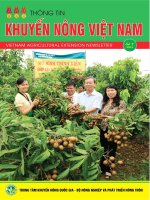07 tran van viet 3rd apr 2014
Bạn đang xem bản rút gọn của tài liệu. Xem và tải ngay bản đầy đủ của tài liệu tại đây (909.31 KB, 24 trang )
Comparison of water quality in
rotation of shrimp - rice farming system
in Ca Mau and Tien Giang
provinces, Mekong delta, Vietnam
T. V. Viet(1), H.T. Giang(1), N.M.N.Quang(2) and V.N.Ut(1)
College of Aquaculture, Can Tho Univerisity, Vietnam
2
Agriculture Extension Center of Tien Giang province, Vietnam
1
1
Background
Area of aquaculture in the Mekong
delta and Vietnam
72,5 %
63,5 %
2
Background
Shrimp production from aquaculture
3
Background
- Export value from shrimp: 3.0 billions USD
in 2013 (VASEP, 2014)
- Mekong delta contributes over 70% of the
country
- Many systems:
+ Intensive
+ Semi-intensive
+ Integrated mangrove-shrimp farming
system
+ Rotation of rice shrimp farming system.
4
Rotation of rice shrimp farming
system
-This system only applies in the coastal
- where has freshwater in rainy and brackish water
in the dry seasons
Shrimp culture
Black tiger shrimp (Penaeus monodon)
Dry season salinity > 3ppt
Rice paddy
Rainy season: salinity < 3ppt
5
Diagram of the system in
the Mekong Delta
6
Seasonal for the farming system
Depend on: - Location
- Irrigational system of each region
- Freshwater source for rice growing
- Brackish water for shrimp culture
- Rainfall of year /weather
Water quality is fluctuated in both of temporal
and spatial
7
Contents of the study
-To assess water quality and yield ( shrimp)
in rotation of rice shrimp farming system
- To find out effect factors to shrimp culture
8
Methodology
-The study is carried
out in 2003
-Tan Phu Dong, Tien
Giang provinces (TG)
in Eastern of the MD
- Thoi Binh, Ca Mau
province (CM) in the
western of the MD
9
Experimental design in each province
Area of each from:0.5-2.4 ha
10
Sampling
(6 times for each farm)
Aug=1 st
Oct = 2nd
First two times
Early and late cropping
Jan=3rd
Feb= 4th
Mar=5th
Apr=6th
Last four times
Each time per month
11
Results
Aug Sept Oct
..
12

